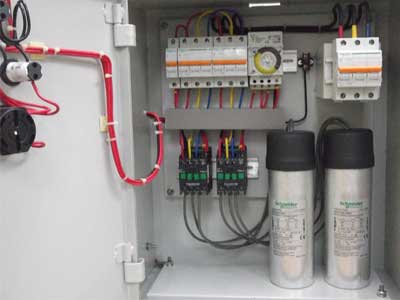What Is Power Factor Correction?
Key Takeaway
Power factor correction is the process of improving the power factor of an electrical system. Power factor measures how effectively electrical power is being used. It is the ratio of real power (used to do work) to apparent power (total power supplied). Poor power factor means more power is wasted. To correct this, capacitors are added to the system. These capacitors offset the lagging current caused by inductive loads, like motors and transformers, making the power factor closer to one (unity). This process increases efficiency and reduces energy costs.
Definition and Importance of Power Factor
Power factor is a measure of how effectively electrical power is being used. It is defined as the ratio of real power (measured in kilowatts, kW) to apparent power (measured in kilovolt-amperes, kVA). The power factor indicates the efficiency with which the electrical power is converted into useful work output. A power factor of 1 (or 100%) means all the power is effectively used, while a lower power factor indicates inefficiency, leading to increased energy costs and potential penalties from utility companies. Improving power factor is crucial as it reduces energy waste, lowers electricity bills, and enhances the capacity of the electrical system.

Methods of Power Factor Correction
Several methods are used to improve power factor, each suited to different applications and levels of correction needed:
Capacitor Banks: The most common method involves installing capacitors in parallel with the inductive loads. Capacitors provide leading reactive power, which cancels out the lagging reactive power caused by inductive loads, thus improving the power factor.
Synchronous Condensers: These are essentially synchronous motors running without a mechanical load. By adjusting the excitation, synchronous condensers can supply or absorb reactive power, thereby correcting the power factor.
Static Var Compensators (SVC): These devices use thyristors to control capacitors and reactors, providing dynamic power factor correction. SVCs are used in systems requiring rapid adjustment of reactive power.
Active Power Factor Correction (APFC): APFC uses power electronics to control the power factor dynamically. It provides precise correction and is often used in high-performance applications where maintaining a high power factor is critical.
Benefits of Power Factor Correction
Implementing power factor correction offers several significant benefits:
Reduced Energy Costs: Improving power factor reduces the amount of reactive power, leading to lower energy consumption and thus lower electricity bills.
Enhanced System Capacity: By reducing the reactive power, power factor correction frees up capacity in the electrical system, allowing more equipment to be added without upgrading the infrastructure.
Lower Carbon Footprint: Efficient use of electrical power reduces overall energy consumption, contributing to lower greenhouse gas emissions and a reduced carbon footprint.
Improved Voltage Stability: Power factor correction enhances voltage stability in the power system, ensuring consistent and reliable operation of electrical equipment.
Avoidance of Penalties: Many utility companies charge penalties for low power factor. Correcting the power factor helps avoid these additional costs.
Applications of Power Factor Correction
Power factor correction is applied across various sectors to improve energy efficiency and reduce operational costs:
Industrial Facilities: In industries with heavy machinery and inductive loads, such as manufacturing plants, power factor correction is essential to maintain efficiency and reduce energy costs.
Commercial Buildings: Large commercial buildings with extensive HVAC systems and lighting benefit from power factor correction by lowering energy bills and enhancing system capacity.
Renewable Energy Systems: Power factor correction is crucial in renewable energy systems like wind and solar farms to ensure efficient power delivery and grid stability.
Data Centers: With high power demands and critical uptime requirements, data centers use power factor correction to improve efficiency and reliability.
Challenges and Solutions in Power Factor Correction
Despite its benefits, implementing power factor correction can present challenges:
Initial Costs: The installation of capacitors, synchronous condensers, or SVCs can be costly. However, the long-term savings in energy costs often justify the initial investment.
Maintenance Requirements: Power factor correction equipment requires regular maintenance to ensure reliable operation. Implementing a routine maintenance schedule can mitigate this issue.
Harmonics: Adding capacitors can introduce harmonic distortion into the system. Using harmonic filters alongside capacitors can address this problem.
Dynamic Loads: In systems with rapidly changing loads, static correction methods may not be sufficient. Using dynamic solutions like APFC or SVCs can provide the necessary flexibility.
Conclusion
Power factor correction is a vital strategy for enhancing the efficiency and reliability of electrical systems. By improving power factor, engineers can reduce energy costs, increase system capacity, and contribute to a more sustainable environment. For newly joined engineers, mastering power factor correction techniques is essential for optimizing energy use and ensuring the reliable operation of electrical systems across various applications. Understanding and addressing the challenges associated with power factor correction will lead to more effective and efficient power management solutions.

